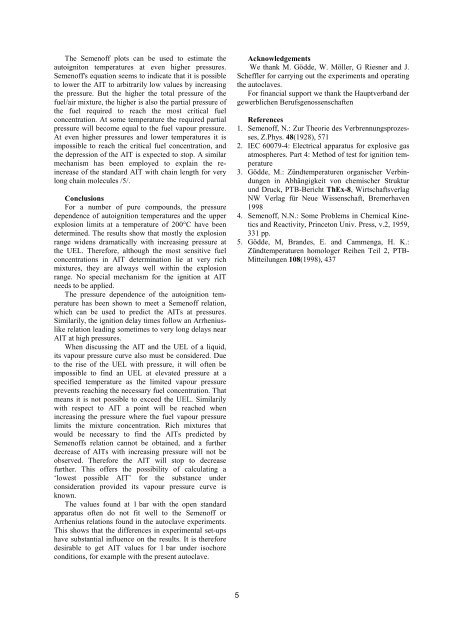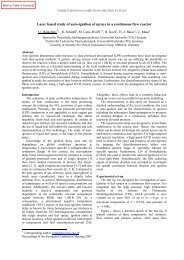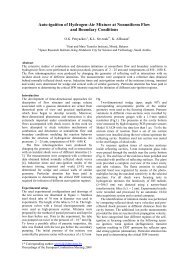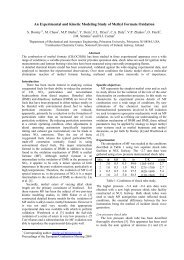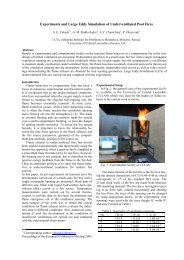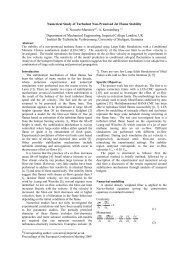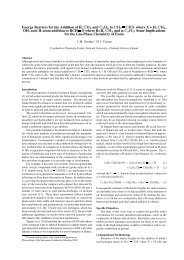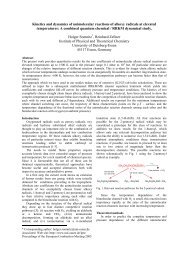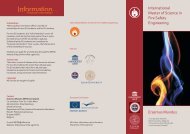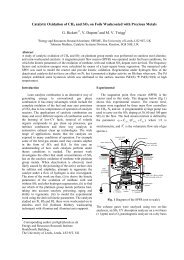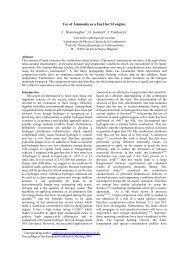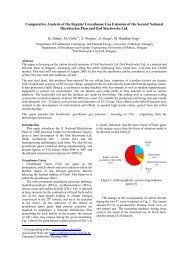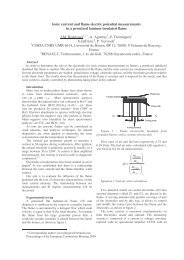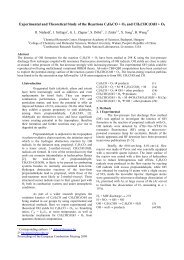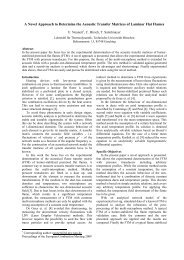Autoignition Temperatures for Mixtures of Flammable Liquids with ...
Autoignition Temperatures for Mixtures of Flammable Liquids with ...
Autoignition Temperatures for Mixtures of Flammable Liquids with ...
You also want an ePaper? Increase the reach of your titles
YUMPU automatically turns print PDFs into web optimized ePapers that Google loves.
The Semen<strong>of</strong>f plots can be used to estimate the<br />
autoigniton temperatures at even higher pressures.<br />
Semen<strong>of</strong>f's equation seems to indicate that it is possible<br />
to lower the AIT to arbitrarily low values by increasing<br />
the pressure. But the higher the total pressure <strong>of</strong> the<br />
fuel/air mixture, the higher is also the partial pressure <strong>of</strong><br />
the fuel required to reach the most critical fuel<br />
concentration. At some temperature the required partial<br />
pressure will become equal to the fuel vapour pressure.<br />
At even higher pressures and lower temperatures it is<br />
impossible to reach the critical fuel concentration, and<br />
the depression <strong>of</strong> the AIT is expected to stop. A similar<br />
mechanism has been employed to explain the reincrease<br />
<strong>of</strong> the standard AIT <strong>with</strong> chain length <strong>for</strong> very<br />
long chain molecules /5/.<br />
Conclusions<br />
For a number <strong>of</strong> pure compounds, the pressure<br />
dependence <strong>of</strong> autoignition temperatures and the upper<br />
explosion limits at a temperature <strong>of</strong> 200°C have been<br />
determined. The results show that mostly the explosion<br />
range widens dramatically <strong>with</strong> increasing pressure at<br />
the UEL. There<strong>for</strong>e, although the most sensitive fuel<br />
concentrations in AIT determination lie at very rich<br />
mixtures, they are always well <strong>with</strong>in the explosion<br />
range. No special mechanism <strong>for</strong> the ignition at AIT<br />
needs to be applied.<br />
The pressure dependence <strong>of</strong> the autoignition temperature<br />
has been shown to meet a Semen<strong>of</strong>f relation,<br />
which can be used to predict the AITs at pressures.<br />
Similarily, the ignition delay times follow an Arrheniuslike<br />
relation leading sometimes to very long delays near<br />
AIT at high pressures.<br />
When discussing the AIT and the UEL <strong>of</strong> a liquid,<br />
its vapour pressure curve also must be considered. Due<br />
to the rise <strong>of</strong> the UEL <strong>with</strong> pressure, it will <strong>of</strong>ten be<br />
impossible to find an UEL at elevated pressure at a<br />
specified temperature as the limited vapour pressure<br />
prevents reaching the necessary fuel concentration. That<br />
means it is not possible to exceed the UEL. Similarily<br />
<strong>with</strong> respect to AIT a point will be reached when<br />
increasing the pressure where the fuel vapour pressure<br />
limits the mixture concentration. Rich mixtures that<br />
would be necessary to find the AITs predicted by<br />
Semen<strong>of</strong>fs relation cannot be obtained, and a further<br />
decrease <strong>of</strong> AITs <strong>with</strong> increasing pressure will not be<br />
observed. There<strong>for</strong>e the AIT will stop to decrease<br />
further. This <strong>of</strong>fers the possibility <strong>of</strong> calculating a<br />
‘lowest possible AIT’ <strong>for</strong> the substance under<br />
consideration provided its vapour pressure curve is<br />
known.<br />
The values found at 1 bar <strong>with</strong> the open standard<br />
apparatus <strong>of</strong>ten do not fit well to the Semen<strong>of</strong>f or<br />
Arrhenius relations found in the autoclave experiments.<br />
This shows that the differences in experimental set-ups<br />
have substantial influence on the results. It is there<strong>for</strong>e<br />
desirable to get AIT values <strong>for</strong> 1 bar under isochore<br />
conditions, <strong>for</strong> example <strong>with</strong> the present autoclave.<br />
Acknowledgements<br />
We thank M. Gödde, W. Möller, G Riesner and J.<br />
Scheffler <strong>for</strong> carrying out the experiments and operating<br />
the autoclaves.<br />
For financial support we thank the Hauptverband der<br />
gewerblichen Berufsgenossenschaften<br />
References<br />
1. Semen<strong>of</strong>f, N.: Zur Theorie des Verbrennungsprozesses,<br />
Z.Phys. 48(1928), 571<br />
2. IEC 60079-4: Electrical apparatus <strong>for</strong> explosive gas<br />
atmospheres. Part 4: Method <strong>of</strong> test <strong>for</strong> ignition temperature<br />
3. Gödde, M.: Zündtemperaturen organischer Verbindungen<br />
in Abhängigkeit von chemischer Struktur<br />
und Druck, PTB-Bericht ThEx-8, Wirtschaftsverlag<br />
NW Verlag für Neue Wissenschaft, Bremerhaven<br />
1998<br />
4. Semen<strong>of</strong>f, N.N.: Some Problems in Chemical Kinetics<br />
and Reactivity, Princeton Univ. Press, v.2, 1959,<br />
331 pp.<br />
5. Gödde, M, Brandes, E. and Cammenga, H. K.:<br />
Zündtemperaturen homologer Reihen Teil 2, PTB-<br />
Mitteilungen 108(1998), 437<br />
5


